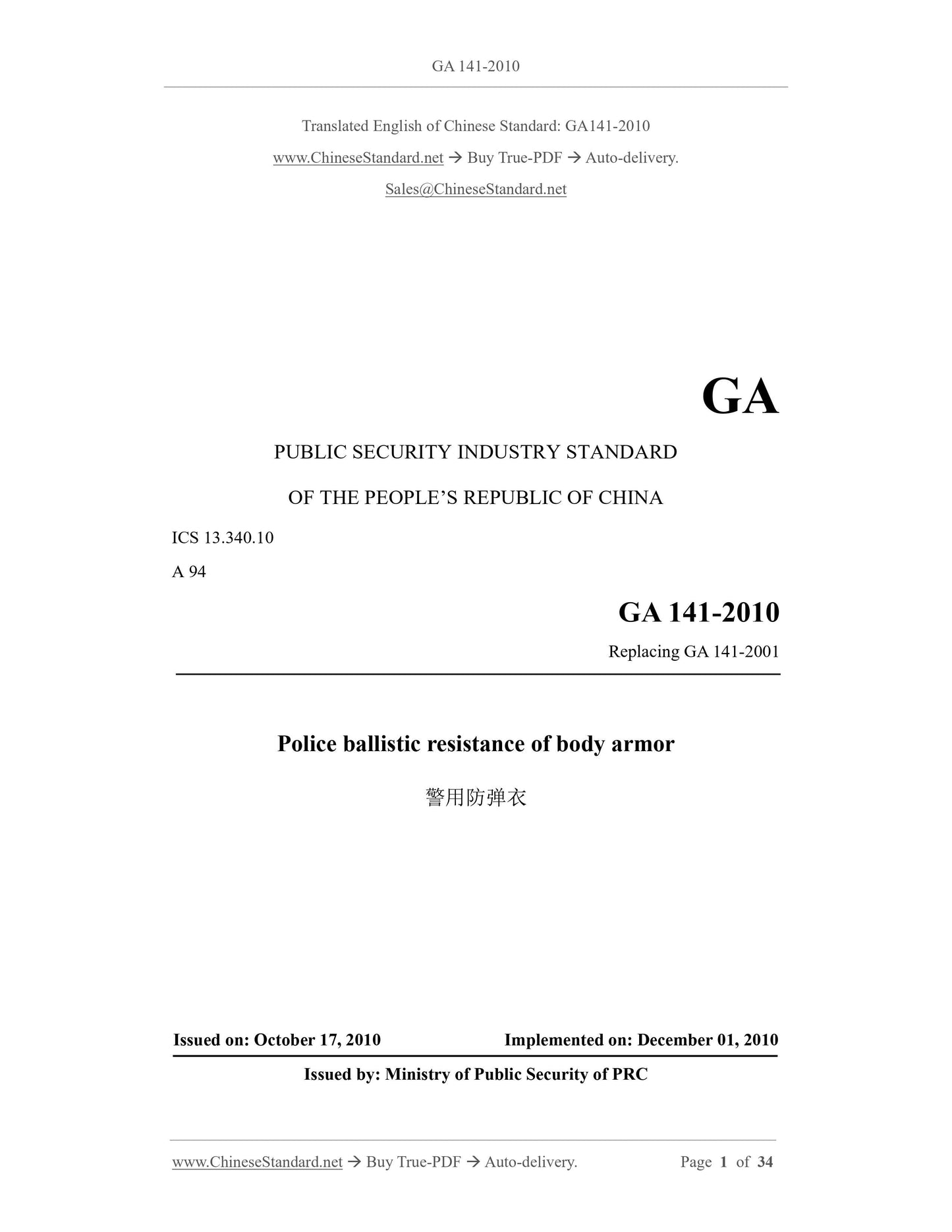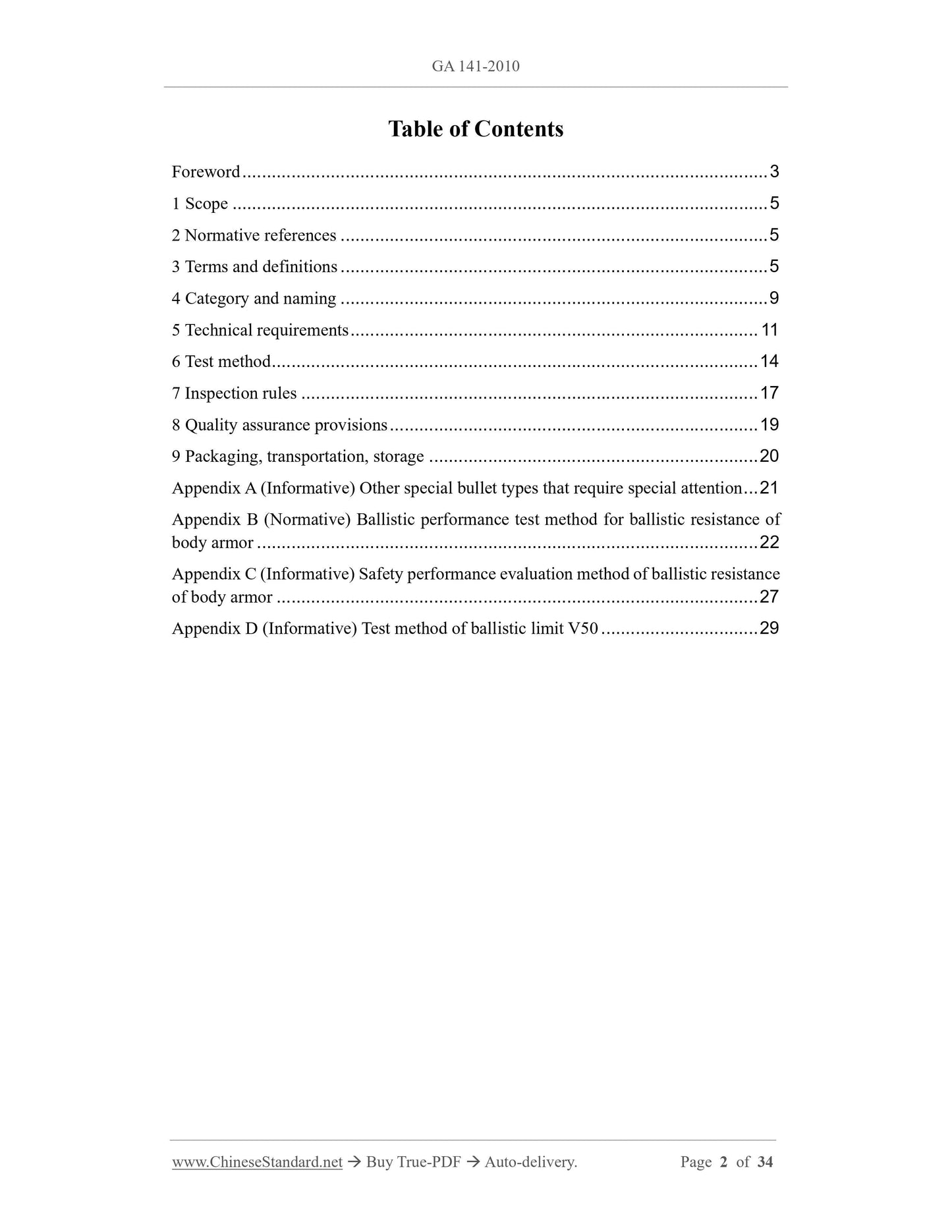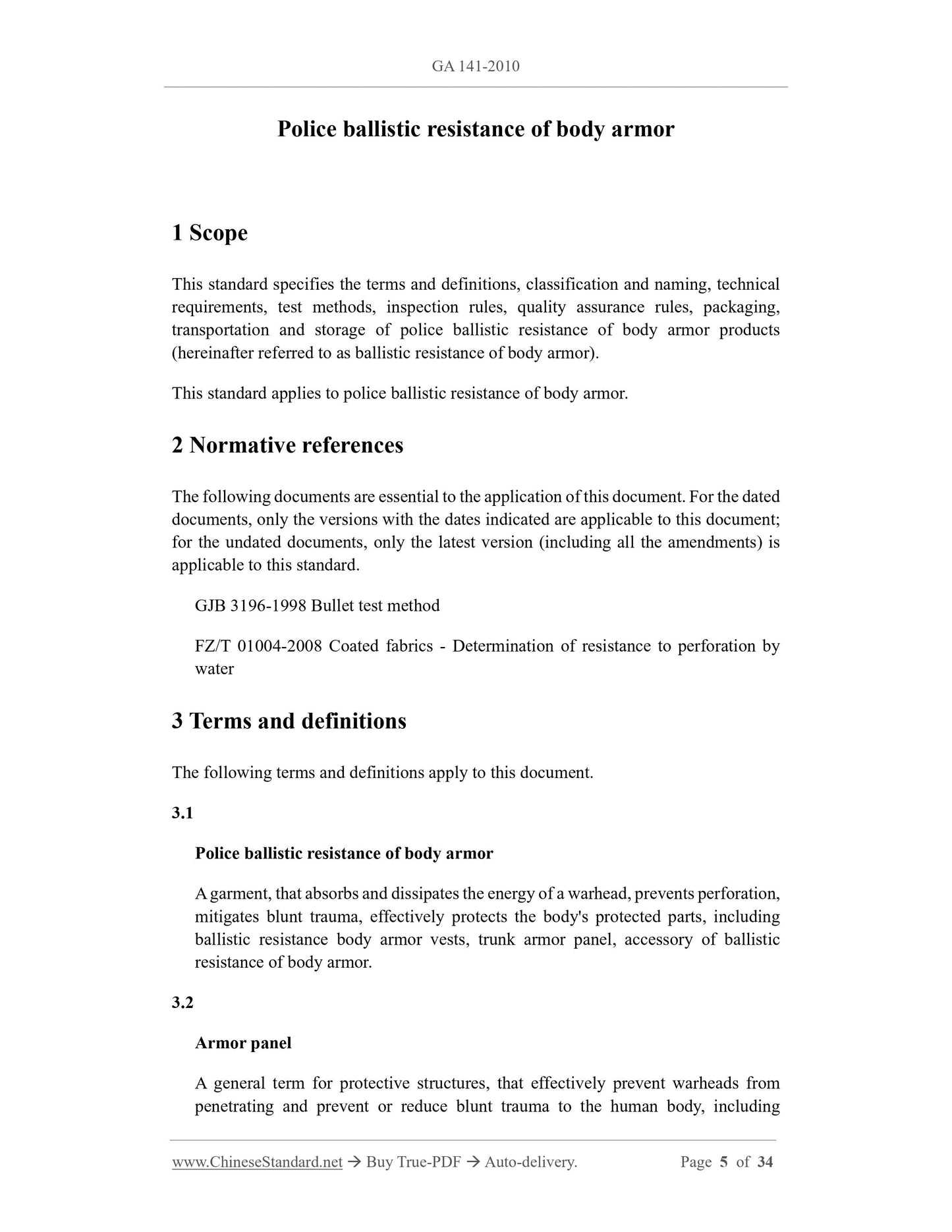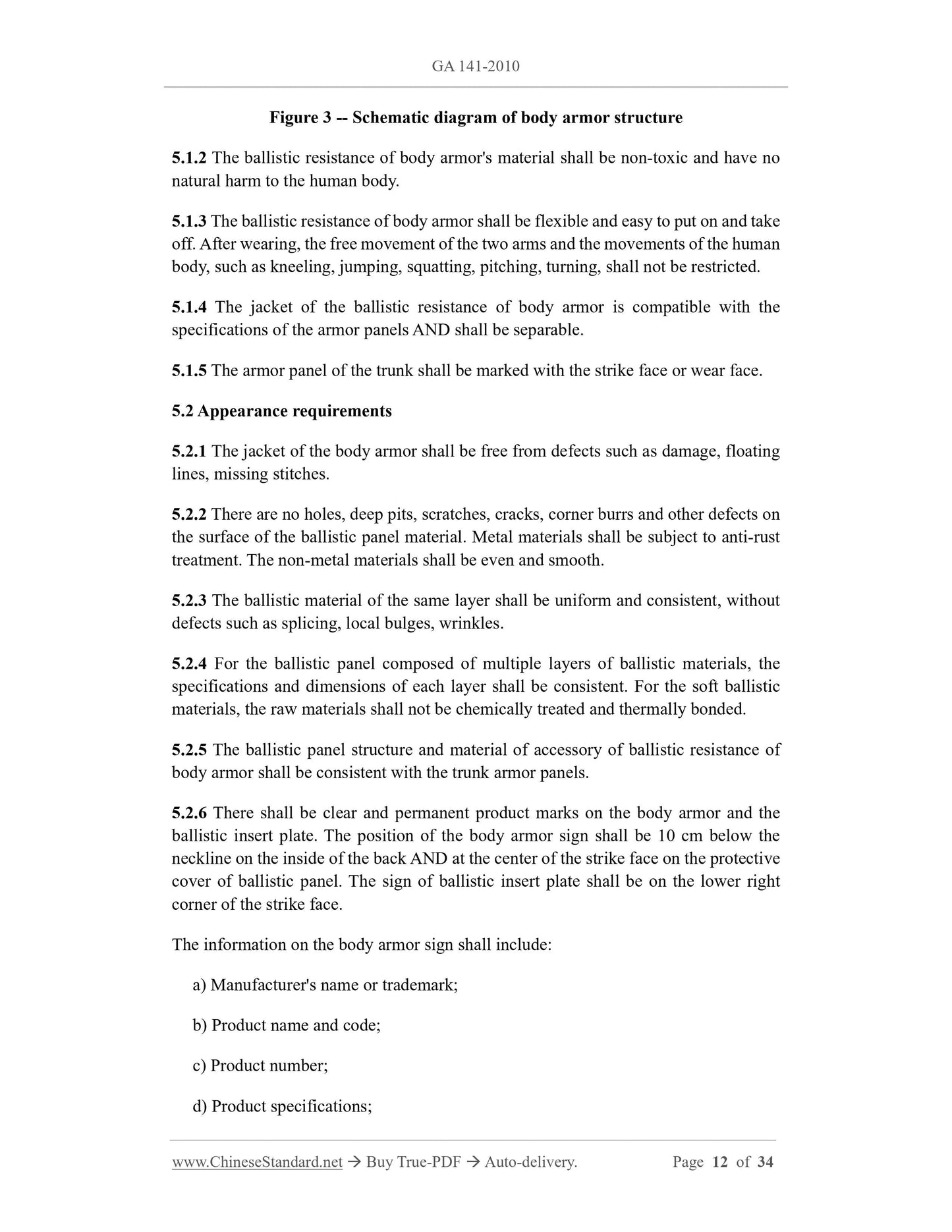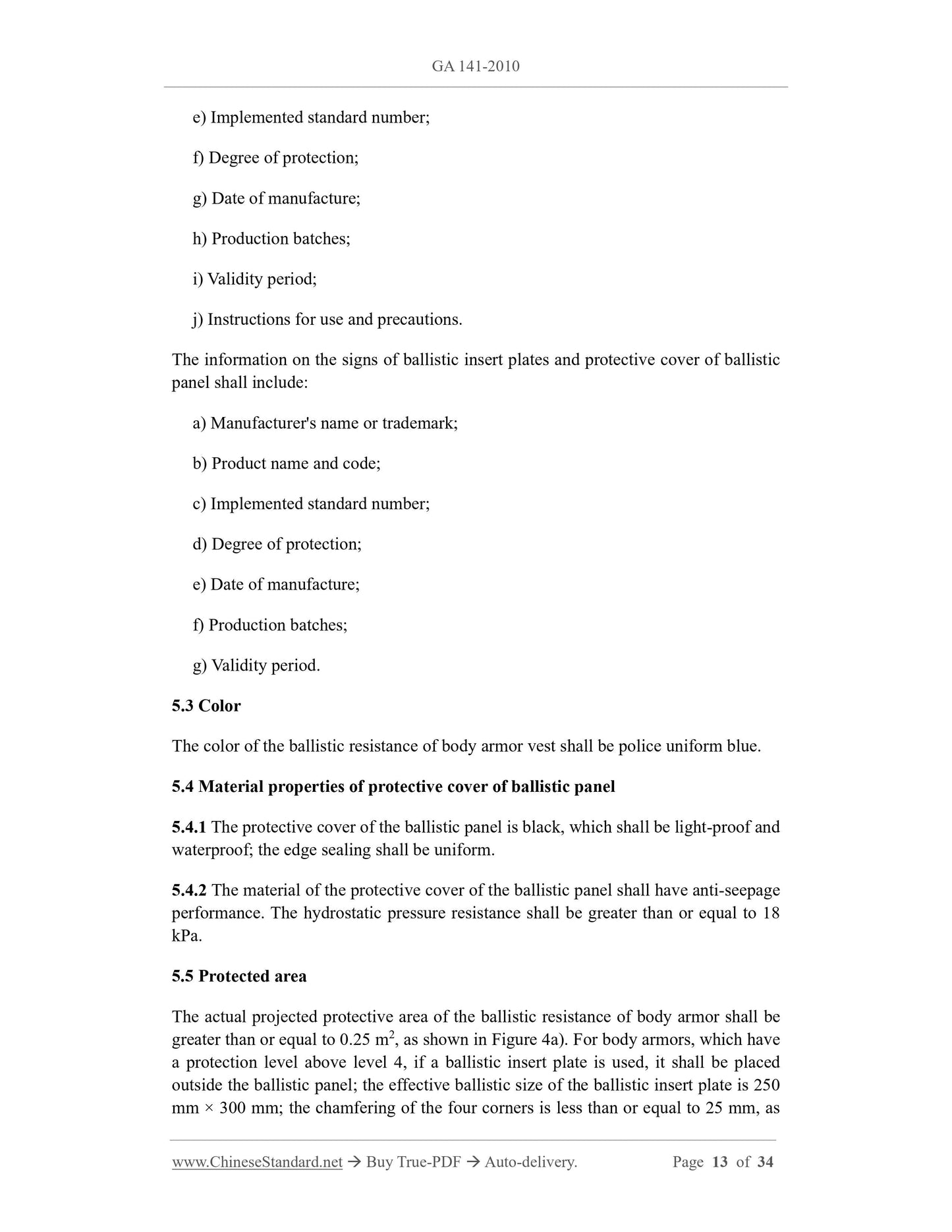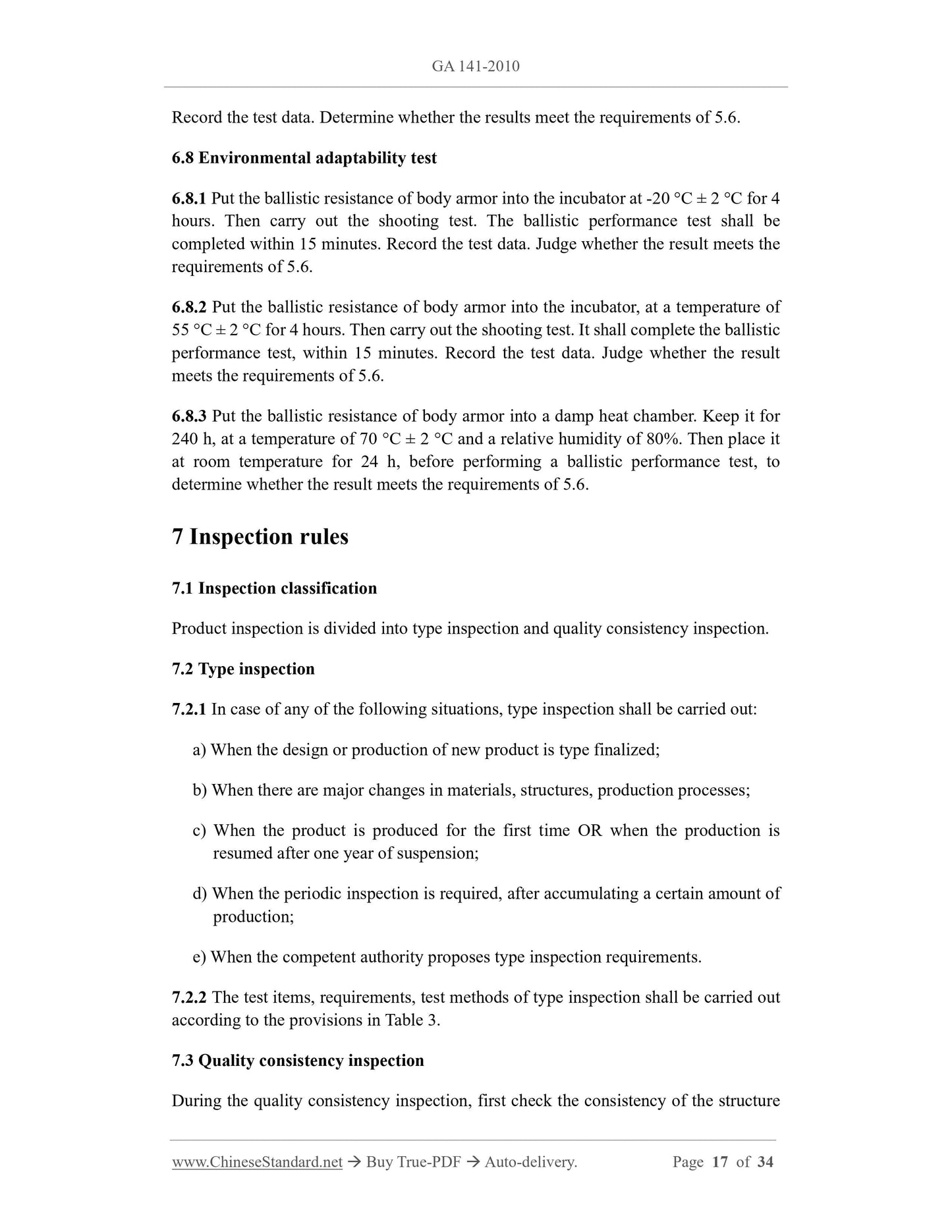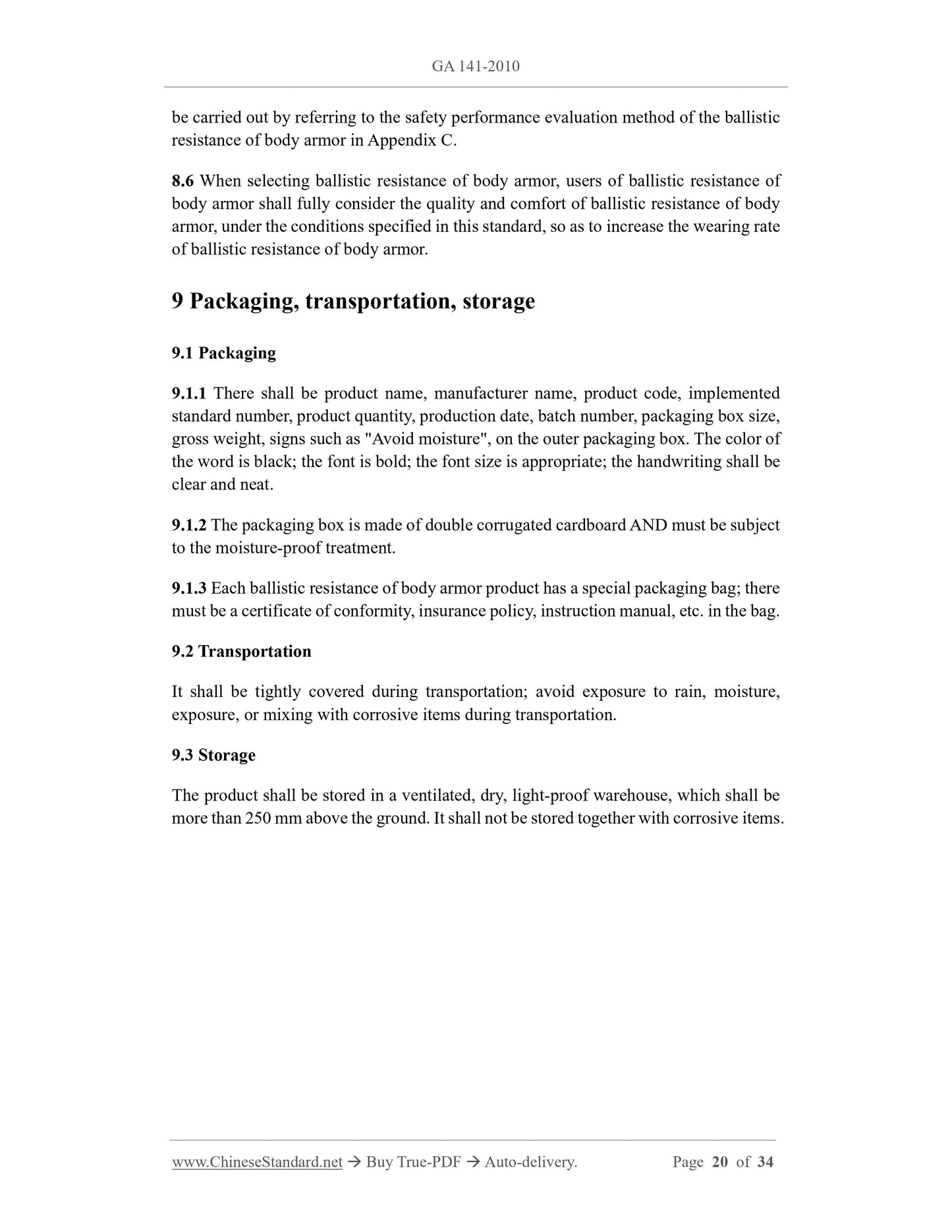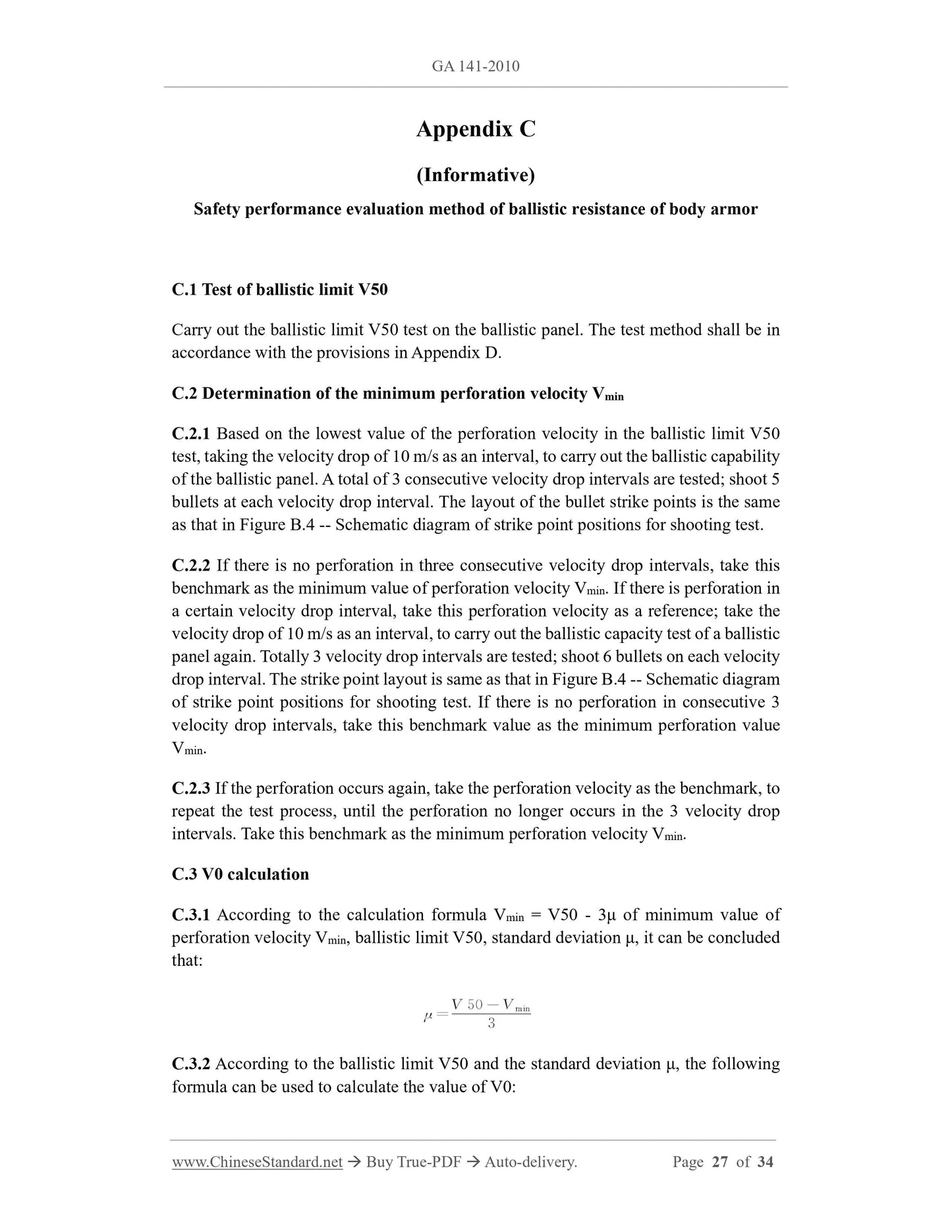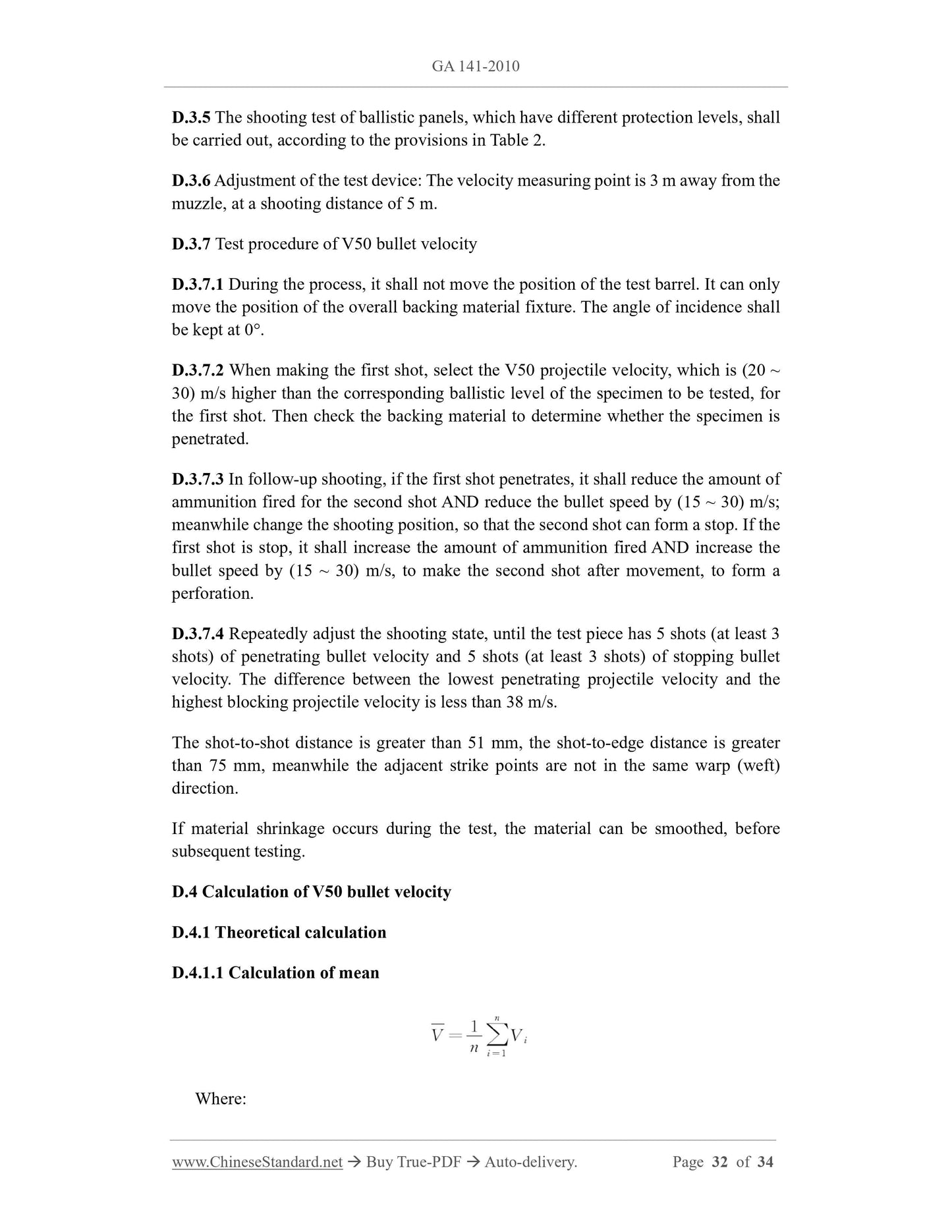1
/
of
9
PayPal, credit cards. Download editable-PDF and invoice in 1 second!
GA 141-2010 English PDF (GA141-2010)
GA 141-2010 English PDF (GA141-2010)
Regular price
$395.00 USD
Regular price
Sale price
$395.00 USD
Unit price
/
per
Shipping calculated at checkout.
Couldn't load pickup availability
Delivery: 3 seconds. Download true-PDF + Invoice.
Get QUOTATION in 1-minute: Click GA 141-2010
Historical versions: GA 141-2010
Preview True-PDF (Reload/Scroll if blank)
GA 141-2010: Police ballistic resistance of body armor
GA 141-2010
GA
PUBLIC SECURITY INDUSTRY STANDARD
OF THE PEOPLE’S REPUBLIC OF CHINA
ICS 13.340.10
A 94
Replacing GA 141-2001
Police ballistic resistance of body armor
ISSUED ON: OCTOBER 17, 2010
IMPLEMENTED ON: DECEMBER 01, 2010
Issued by: Ministry of Public Security of PRC
Table of Contents
Foreword ... 3
1 Scope ... 5
2 Normative references ... 5
3 Terms and definitions ... 5
4 Category and naming ... 9
5 Technical requirements ... 11
6 Test method ... 14
7 Inspection rules ... 17
8 Quality assurance provisions ... 19
9 Packaging, transportation, storage ... 20
Appendix A (Informative) Other special bullet types that require special attention ... 21
Appendix B (Normative) Ballistic performance test method for ballistic resistance of
body armor ... 22
Appendix C (Informative) Safety performance evaluation method of ballistic resistance
of body armor ... 27
Appendix D (Informative) Test method of ballistic limit V50 ... 29
Police ballistic resistance of body armor
1 Scope
This standard specifies the terms and definitions, classification and naming, technical
requirements, test methods, inspection rules, quality assurance rules, packaging,
transportation and storage of police ballistic resistance of body armor products
(hereinafter referred to as ballistic resistance of body armor).
This standard applies to police ballistic resistance of body armor.
2 Normative references
The following documents are essential to the application of this document. For the dated
documents, only the versions with the dates indicated are applicable to this document;
for the undated documents, only the latest version (including all the amendments) is
applicable to this standard.
GJB 3196-1998 Bullet test method
FZ/T 01004-2008 Coated fabrics - Determination of resistance to perforation by
water
3 Terms and definitions
The following terms and definitions apply to this document.
3.1
Police ballistic resistance of body armor
A garment, that absorbs and dissipates the energy of a warhead, prevents perforation,
mitigates blunt trauma, effectively protects the body's protected parts, including
ballistic resistance body armor vests, trunk armor panel, accessory of ballistic
resistance of body armor.
3.2
Armor panel
A general term for protective structures, that effectively prevent warheads from
penetrating and prevent or reduce blunt trauma to the human body, including
Figure 3 -- Schematic diagram of body armor structure
5.1.2 The ballistic resistance of body armor's material shall be non-toxic and have no
natural harm to the human body.
5.1.3 The ballistic resistance of body armor shall be flexible and easy to put on and take
off. After wearing, the free movement of the two arms and the movements of the human
body, such as kneeling, jumping, squatting, pitching, turning, shall not be restricted.
5.1.4 The jacket of the ballistic resistance of body armor is compatible with the
specifications of the armor panels AND shall be separable.
5.1.5 The armor panel of the trunk shall be marked with the strike face or wear face.
5.2 Appearance requirements
5.2.1 The jacket of the body armor shall be free from defects such as damage, floating
lines, missing stitches.
5.2.2 There are no holes, deep pits, scratches, cracks, corner burrs and other defects on
the surface of the ballistic panel material. Metal materials shall be subject to anti-rust
treatment. The non-metal materials shall be even and smooth.
5.2.3 The ballistic material of the same layer shall be uniform and consistent, without
defects such as splicing, local bulges, wrinkles.
5.2.4 For the ballistic panel composed of multiple layers of ballistic materials, the
specifications and dimensions of each layer shall be consistent. For the soft ballistic
materials, the raw materials shall not be chemically treated and thermally bonded.
5.2.5 The ballistic panel structure and material of accessory of ballistic resistance of
body armor shall be consistent with the trunk armor panels.
5.2.6 There shall be clear and permanent product marks on the body armor and the
ballistic insert plate. The position of the body armor sign shall be 10 cm below the
neckline on the inside of the back AND at the center of the strike face on the protective
cover of ballistic panel. The sign of ballistic insert plate shall be on the lower right
corner of the strike face.
The information on the body armor sign shall include:
a) Manufacturer's name or trademark;
b) Product name and code;
c) Product number;
d) Product specifications;
e) Implemented standard number;
f) Degree of protection;
g) Date of manufacture;
h) Production batches;
i) Validity period;
j) Instructions for use and precautions.
The information on the signs of ballistic insert plates and protective cover of ballistic
panel shall include:
a) Manufacturer's name or trademark;
b) Product name and code;
c) Implemented standard number;
d) Degree of protection;
e) Date of manufacture;
f) Production batches;
g) Validity period.
5.3 Color
The color of the ballistic resistance of body armor vest shall be police uniform blue.
5.4 Material properties of protective cover of ballistic panel
5.4.1 The protective cover of the ballistic panel is black, which shall be light-proof and
waterproof; the edge sealing shall be uniform.
5.4.2 The material of the protective cover of the ballistic panel shall have anti-seepage
performance. The hydrostatic pressure resistance shall be greater than or equal to 18
kPa.
5.5 Protected area
The actual projected protective area of the ballistic resistance of body armor shall be
greater than or equal to 0.25 m2, as shown in Figure 4a). For body armors, which have
a protection level above level 4, if a ballistic insert plate is used, it shall be placed
outside the ballistic panel; the effective ballistic size of the ballistic insert plate is 250
mm × 300 mm; the chamfering of the four corners is less than or equal to 25 mm, as
Record the test data. Determine whether the results meet the requirements of 5.6.
6.8 Environmental adaptability test
6.8.1 Put the ballistic resistance of body armor into the incubator at -20 °C ± 2 °C for 4
hours. Then carry out the shooting test. The ballistic performance test shall be
completed within 15 minutes. Record the test data. Judge whether the result meets the
requirements of 5.6.
6.8.2 Put the ballistic resistance of body armor into the incubator, at a temperature of
55 °C ± 2 °C for 4 hours. Then carry out the shooting test. It shall complete the ballistic
performance test, within 15 minutes. Record the test data. Judge whether the result
meets the requirements of 5.6.
6.8.3 Put the ballistic resistance of body armor into a damp heat chamber. Keep it for
240 h, at a temperature of 70 °C ± 2 °C and a relative humidity of 80%. Then place it
at room temperature for 24 h, before performing a ballistic performance test, to
determine whether the result meets the requirements of 5.6.
7 Inspection rules
7.1 Inspection classification
Product inspection is divided into type inspection and quality consistency inspection.
7.2 Type inspection
7.2.1 In case of any of the following situations, type inspection shall be carried out:
a) When the design or production of new product is type finalized;
b) When there are major changes in materials, structures, production processes;
c) When t...
Get QUOTATION in 1-minute: Click GA 141-2010
Historical versions: GA 141-2010
Preview True-PDF (Reload/Scroll if blank)
GA 141-2010: Police ballistic resistance of body armor
GA 141-2010
GA
PUBLIC SECURITY INDUSTRY STANDARD
OF THE PEOPLE’S REPUBLIC OF CHINA
ICS 13.340.10
A 94
Replacing GA 141-2001
Police ballistic resistance of body armor
ISSUED ON: OCTOBER 17, 2010
IMPLEMENTED ON: DECEMBER 01, 2010
Issued by: Ministry of Public Security of PRC
Table of Contents
Foreword ... 3
1 Scope ... 5
2 Normative references ... 5
3 Terms and definitions ... 5
4 Category and naming ... 9
5 Technical requirements ... 11
6 Test method ... 14
7 Inspection rules ... 17
8 Quality assurance provisions ... 19
9 Packaging, transportation, storage ... 20
Appendix A (Informative) Other special bullet types that require special attention ... 21
Appendix B (Normative) Ballistic performance test method for ballistic resistance of
body armor ... 22
Appendix C (Informative) Safety performance evaluation method of ballistic resistance
of body armor ... 27
Appendix D (Informative) Test method of ballistic limit V50 ... 29
Police ballistic resistance of body armor
1 Scope
This standard specifies the terms and definitions, classification and naming, technical
requirements, test methods, inspection rules, quality assurance rules, packaging,
transportation and storage of police ballistic resistance of body armor products
(hereinafter referred to as ballistic resistance of body armor).
This standard applies to police ballistic resistance of body armor.
2 Normative references
The following documents are essential to the application of this document. For the dated
documents, only the versions with the dates indicated are applicable to this document;
for the undated documents, only the latest version (including all the amendments) is
applicable to this standard.
GJB 3196-1998 Bullet test method
FZ/T 01004-2008 Coated fabrics - Determination of resistance to perforation by
water
3 Terms and definitions
The following terms and definitions apply to this document.
3.1
Police ballistic resistance of body armor
A garment, that absorbs and dissipates the energy of a warhead, prevents perforation,
mitigates blunt trauma, effectively protects the body's protected parts, including
ballistic resistance body armor vests, trunk armor panel, accessory of ballistic
resistance of body armor.
3.2
Armor panel
A general term for protective structures, that effectively prevent warheads from
penetrating and prevent or reduce blunt trauma to the human body, including
Figure 3 -- Schematic diagram of body armor structure
5.1.2 The ballistic resistance of body armor's material shall be non-toxic and have no
natural harm to the human body.
5.1.3 The ballistic resistance of body armor shall be flexible and easy to put on and take
off. After wearing, the free movement of the two arms and the movements of the human
body, such as kneeling, jumping, squatting, pitching, turning, shall not be restricted.
5.1.4 The jacket of the ballistic resistance of body armor is compatible with the
specifications of the armor panels AND shall be separable.
5.1.5 The armor panel of the trunk shall be marked with the strike face or wear face.
5.2 Appearance requirements
5.2.1 The jacket of the body armor shall be free from defects such as damage, floating
lines, missing stitches.
5.2.2 There are no holes, deep pits, scratches, cracks, corner burrs and other defects on
the surface of the ballistic panel material. Metal materials shall be subject to anti-rust
treatment. The non-metal materials shall be even and smooth.
5.2.3 The ballistic material of the same layer shall be uniform and consistent, without
defects such as splicing, local bulges, wrinkles.
5.2.4 For the ballistic panel composed of multiple layers of ballistic materials, the
specifications and dimensions of each layer shall be consistent. For the soft ballistic
materials, the raw materials shall not be chemically treated and thermally bonded.
5.2.5 The ballistic panel structure and material of accessory of ballistic resistance of
body armor shall be consistent with the trunk armor panels.
5.2.6 There shall be clear and permanent product marks on the body armor and the
ballistic insert plate. The position of the body armor sign shall be 10 cm below the
neckline on the inside of the back AND at the center of the strike face on the protective
cover of ballistic panel. The sign of ballistic insert plate shall be on the lower right
corner of the strike face.
The information on the body armor sign shall include:
a) Manufacturer's name or trademark;
b) Product name and code;
c) Product number;
d) Product specifications;
e) Implemented standard number;
f) Degree of protection;
g) Date of manufacture;
h) Production batches;
i) Validity period;
j) Instructions for use and precautions.
The information on the signs of ballistic insert plates and protective cover of ballistic
panel shall include:
a) Manufacturer's name or trademark;
b) Product name and code;
c) Implemented standard number;
d) Degree of protection;
e) Date of manufacture;
f) Production batches;
g) Validity period.
5.3 Color
The color of the ballistic resistance of body armor vest shall be police uniform blue.
5.4 Material properties of protective cover of ballistic panel
5.4.1 The protective cover of the ballistic panel is black, which shall be light-proof and
waterproof; the edge sealing shall be uniform.
5.4.2 The material of the protective cover of the ballistic panel shall have anti-seepage
performance. The hydrostatic pressure resistance shall be greater than or equal to 18
kPa.
5.5 Protected area
The actual projected protective area of the ballistic resistance of body armor shall be
greater than or equal to 0.25 m2, as shown in Figure 4a). For body armors, which have
a protection level above level 4, if a ballistic insert plate is used, it shall be placed
outside the ballistic panel; the effective ballistic size of the ballistic insert plate is 250
mm × 300 mm; the chamfering of the four corners is less than or equal to 25 mm, as
Record the test data. Determine whether the results meet the requirements of 5.6.
6.8 Environmental adaptability test
6.8.1 Put the ballistic resistance of body armor into the incubator at -20 °C ± 2 °C for 4
hours. Then carry out the shooting test. The ballistic performance test shall be
completed within 15 minutes. Record the test data. Judge whether the result meets the
requirements of 5.6.
6.8.2 Put the ballistic resistance of body armor into the incubator, at a temperature of
55 °C ± 2 °C for 4 hours. Then carry out the shooting test. It shall complete the ballistic
performance test, within 15 minutes. Record the test data. Judge whether the result
meets the requirements of 5.6.
6.8.3 Put the ballistic resistance of body armor into a damp heat chamber. Keep it for
240 h, at a temperature of 70 °C ± 2 °C and a relative humidity of 80%. Then place it
at room temperature for 24 h, before performing a ballistic performance test, to
determine whether the result meets the requirements of 5.6.
7 Inspection rules
7.1 Inspection classification
Product inspection is divided into type inspection and quality consistency inspection.
7.2 Type inspection
7.2.1 In case of any of the following situations, type inspection shall be carried out:
a) When the design or production of new product is type finalized;
b) When there are major changes in materials, structures, production processes;
c) When t...
Share
